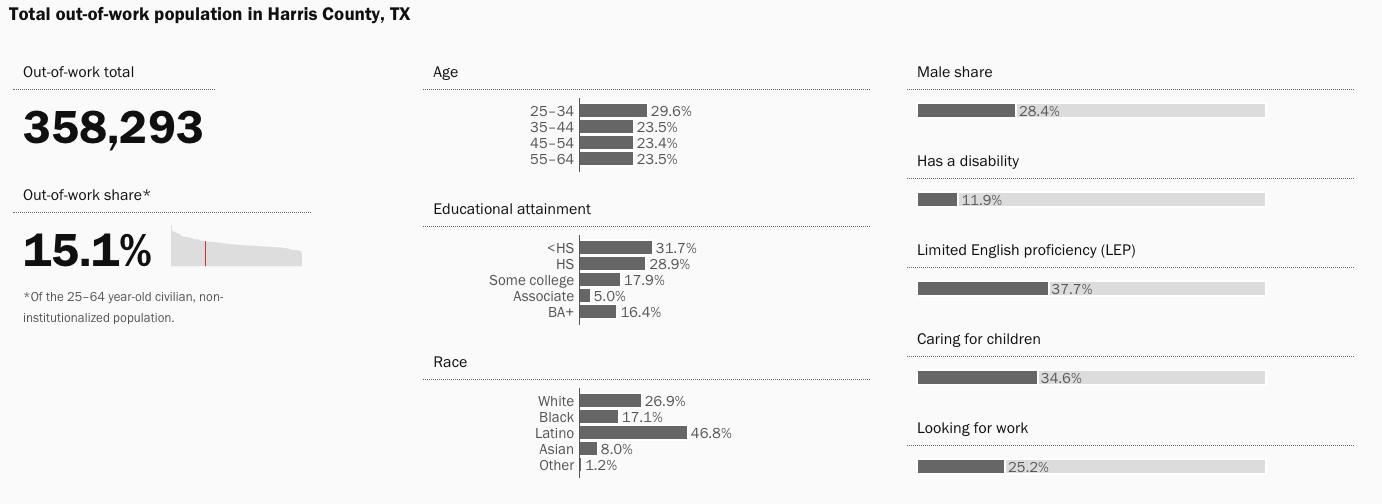There have been recent gains for workers in the United States, including the biggest annual increase in median household incomes ever recorded by the Census between 2014 and 2015. In May, the national unemployment rate fell to 4.3 percent, according to the Bureau of Labor Statistics. But there are still large portions of the population left out. In the Houston metro area, the unemployment rate in May surpassed the national rate at 4.8 percent. Now a new report from the Brookings Institution seeks to put a face on the out-of-work.
The report attempts to get the best estimate of who's out of work in each jurisdiction but would be likely to be interested in some sort of workforce development, meaning they're looking for work. To get that number, the researchers subtracted people receiving retirement or disability benefits who may not be able to work, students, and individuals who appeared to be stay-at-home parents with enough income coming in from their partner from the total number of people who are unemployed or not in the labor force and not living in institutional settings. In the 130 jurisdictions that include almost half of the U.S. population between the ages of 25 and 64, 11.3 million adults are considered out-of-work by this measure. The report then segments out of the out-of-work population in each study area.
Overall the largest group of out-of-work adults are what the report calls "less-educated prime age people." Adults with at most a high school degree made up 37.5 percent of the overall out-of-work population in the study areas. Roughly 43 percent of this group was Latino, nearly half were foreign-born and more than a third were English language learners. Young people also represented a large percentage of the out-of-work population.
In Houston's Harris County, this group represented an even larger portion — 42.5 percent — of the out-of-work population, estimated to be around 358,000 overall. In total, an estimated 15.1 percent of adults ages 25 through 64 were out of work in Harris County. Nearly half — 46.8 percent — were Latino, another 26.9 percent were white and 17.1 percent where black.
Harris County's out-of-work population also tended to be more female, with a higher rate of limited English language proficiency, than the overall study rates. More of those out of work were also responsible for caring for children in Harris County.
Part of the challenge in spread out Harris County is the geography itself and the disconnect between job seekers and employment centers. Maps from the Brookings report break down where each out-of-work population type lives in Harris County. Many of the less-educated and younger or prime-age individuals who are out of work live outside the loop. Highly educated out-of-work folks, on the other hand, have some of their highest concentrations inside the loop. Contrast those maps with one from AllTransit, which shows the numbers of workers accessible within a 30 minute commute on public transit to an average employer. There's a serious mismatch between who is out of work and who can easily reach employers in Harris County.
Not included in the Brookings analysis is another population hard hit by the recession: young adults ages 16 to 24. An estimated 111,000 young adults in Harris County are neither employed nor enrolled in any school, according to a Kinder Institute report. Recently the national unemployment rate for young adults has hovered around pre-recession levels but since 2000 there's been a decline in the participation rate for young adults, a topic explored in an earlier Brookings report. In Houston, the recent expansion of the city's summer jobs program targets this young adult population. Under the new goal, the mayor aimed to employ some 5,000 young adults, well below the targets of similar jobs programs in places like Chicago, Philadelphia and Washington, D.C.

